 advertisements advertisements
|

|
Crawling to the moon, 40 years later: NASA's crawler-transporters
January 23, 2006 — Before NASA could send astronauts to walk on the Moon, space program engineers needed to learn how to crawl.
Forty years ago this month, NASA did just that — as its two crawler transporters entered service in January 1966 to move moon-bound rockets to their launch pads.
On January 13, 2006, NASA marked the anniversary by inviting its Apollo-era drivers and the sons of the engineer who designed the crawler to take a tour as the transporter was moved for a routine operational test.
Adapted from steam shovels used for surface coal mining by the former Marion Power Shovel Company, the crawler transporters are 131 feet long by 113 feet wide, with a flat upper deck that measures 90 feet square — about the size of a baseball diamond — that serves as the carrying surface.
They move on four double-tracked tread belts, similar to those on a military tank. Each tread has 57 "shoes" (456 per crawler) that weigh 2,100 pounds each. At 5.5 million pounds, the crawler alone lumbers forward at 1 mile per hour (its maximum velocity unloaded is 2 miles per hour), pulverizing the river rock that lines its path to the pad into fine dust.
Structurally, the crawlers remain today largely the same machines they were when one carried its first 10.6 million pound Apollo umbilical tower three quarters of a mile on January 28, 1966.
"They've put in more than 3,500 total miles. They've carried numerous different space vehicles, from Saturn V, Saturn IB. They were used to do the fit check of the Enterprise vehicle, as well as supporting all five shuttles that have been in space," said NASA shuttle processing director Michael Wetmore.
"The reason we've been that successful isn't because we've got a 50-year, 5,000-mile warranty" on the crawlers, Wetmore told a crowd of current employees during the anniversary celebration. "It's because of the efforts of the guys behind me who've kept these machines running."
While the two crawlers are still mechanically the same — they are both powered by two 2,750-horsepower diesel engines and a Marion-devised hydraulic system including 16 jacking, equalizing and leveling cylinders — the ways by which they are driven has been modernized.
"We had a joystick up there [in the driver's cabin] during my days," explained Sylvan "Skip" Montagna, a former Bendix employee who drove the crawlers during Apollo. "Today I understand they have little knobs up there. We had the experience of having the controls that were built for it. As [crawler engineer] Bill [Clemens] said, most of them didn't work at the time, and you've got to appreciate this is a machine [that is] one of a kind so all the controls they built for it, they really didn't work right. As time goes on, we kind of refined them and told the engineers what we'd like to have and they'd refine them," said Montagna.
Montagna described to collectSPACE what it was like to drive the crawler with a Saturn V to the pad.
"If we had Apollo to move out of the [Vehicle Assembly Building] to the pad, it took about 10 hours to get it out of there, up to the pad and settled down atop of its mounts. There were three drivers, including myself, and what we'd do is rotate out about every three hours. It was very monotonous driving this machine. What the problem is, is it's so slow — they say the maximum speed is 1 mile per hour, well, it will do that but its not built for that. It will run roughly three-quarters of a mile per hour. So going that slow for that distance and keeping it on the road straight, which you have to do, it's monotonous. It just kind of gets on your nerves all the time because it is very noisy and you're shaking around."
Download an audio mp3 of the crawler in motion
Today, keeping the crawler level and steady is computer monitored and controlled. During Apollo, said Montagna, the process was more primative.
"What was really hard to do is to keep it in a straight line. It likes to wander. It just continually wanders, so you're always tweaking the controls to keep the treads moving [straight] all the time."
"As you go up to the pad, you have an incline going up there. Today they have guidance systems on here, so they go up the pad exactly straight to get up to where to set the vehicle down. We used to run up on a yellow rope. There was rope laid on the roadway going up to the pad and you just kept the edge of the [crawler] just right along the rope and that's how we drove it up there. If you got off the rope, you could get off the pad, so it wasn't too smart either," reflected Montagna.
"We were kind of like dinosaurs, kind of old," Montagna joked.
Despite the challenges, the crawlers (and their drivers) have been very reliable, staying in service throughout the Apollo and Space Shuttle programs. Nor are there any signs of their pending retirement.
"We're hoping that in the future it'll also be carrying a crew launch vehicle and a cargo launch vehicle to support our return to the moon and on to Mars," expressed Wetmore.
|
|
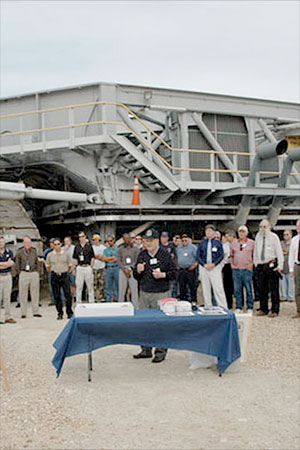
Past and present crawler engineers gather in front of one of the massive transporters on the occasion of the 40th anniversary of its first operational use. (collectSPACE)
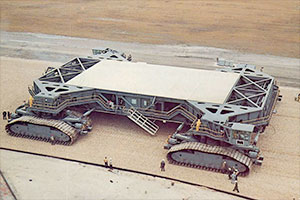
The first crawler transporter as seen two days before beginning service to NASA on Jan. 26, 1966. (NASA)
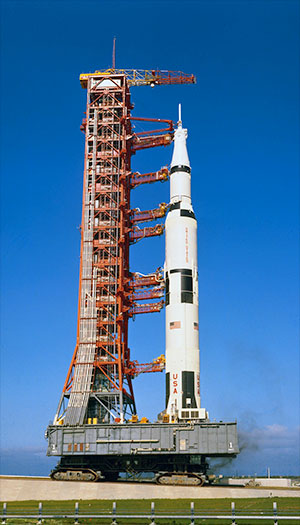
A crawler-transporter keeps Apollo 11's Saturn V rocket, launch umbilical tower and mobile launcher platform level as it climbs the incline to Pad 39A. (NASA) |
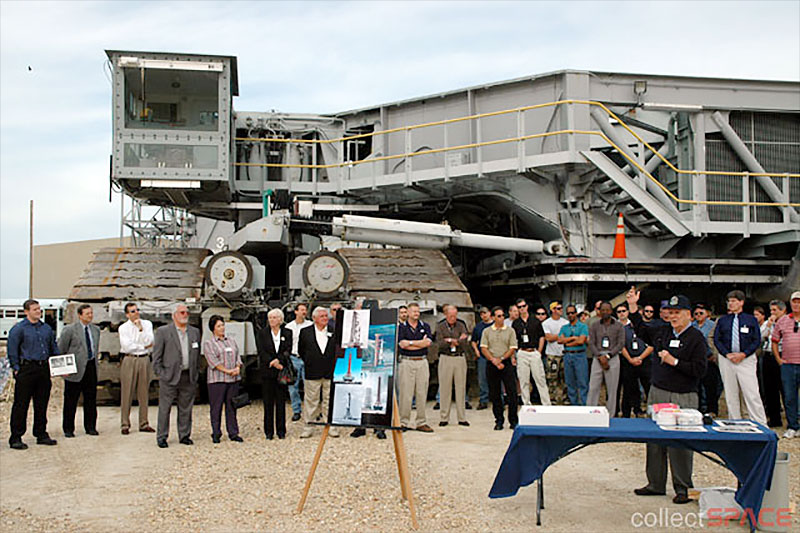
Former crawler engineer Bill Clemens addresses former and present crawler personnel. (collectSPACE) |
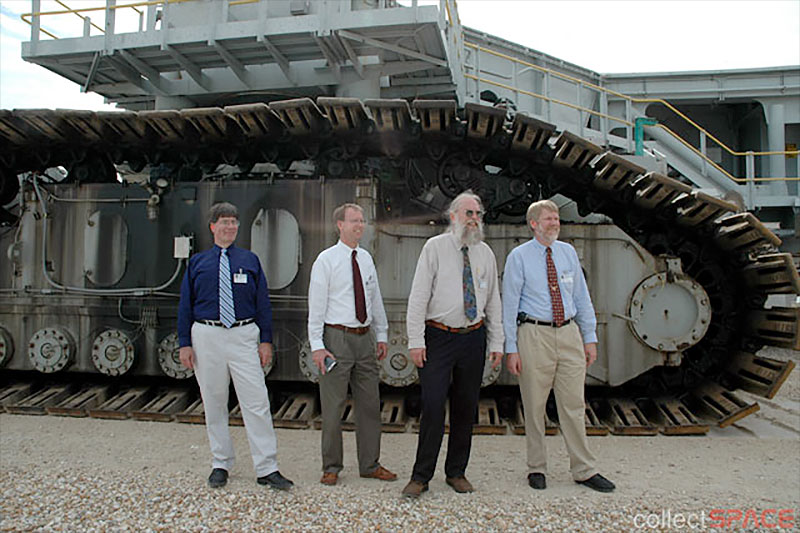
Philip Koehring and his brothers, Doug (white shirt) and John (light blue shirt), with Rick Drollinger (at right). Philip Koehring Sr. was project manager at Marion Power Shovel in Ohio where the crawlers were built in 1965. Drollinger's father, Richard, was director of engineering at Marion. (collectSPACE) |

A close-up of the crawler's tread "shoes." (collectSPACE) |
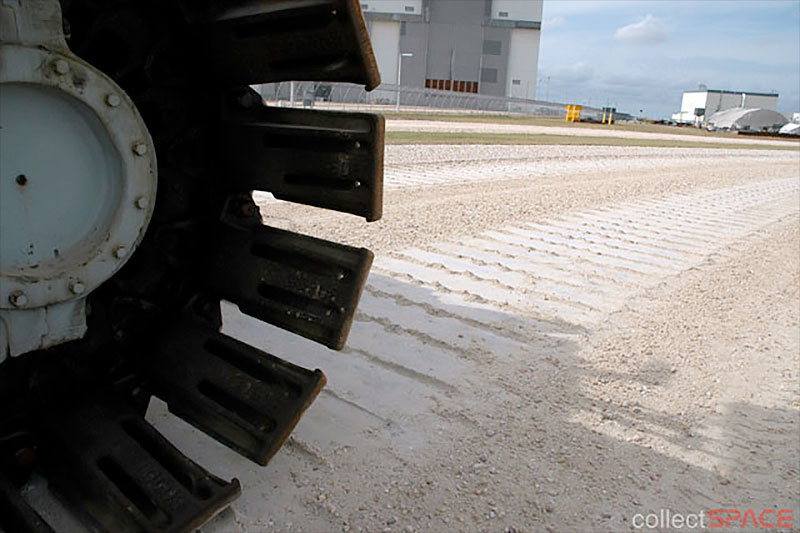
The river rock that lines the crawlerway is pulverized into dust in the transporter's wake. (collectSPACE) |
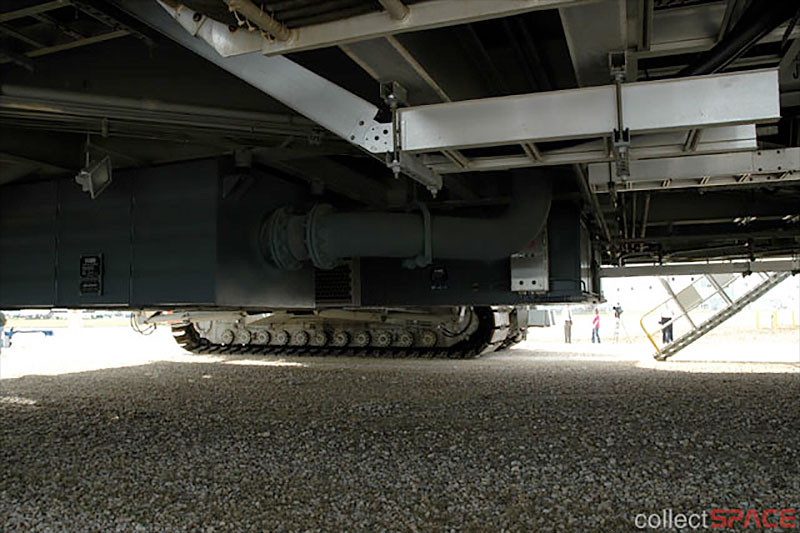
Peering underneath the crawler's platform, the SUV-sized gray box is a muffler. (collectSPACE) |
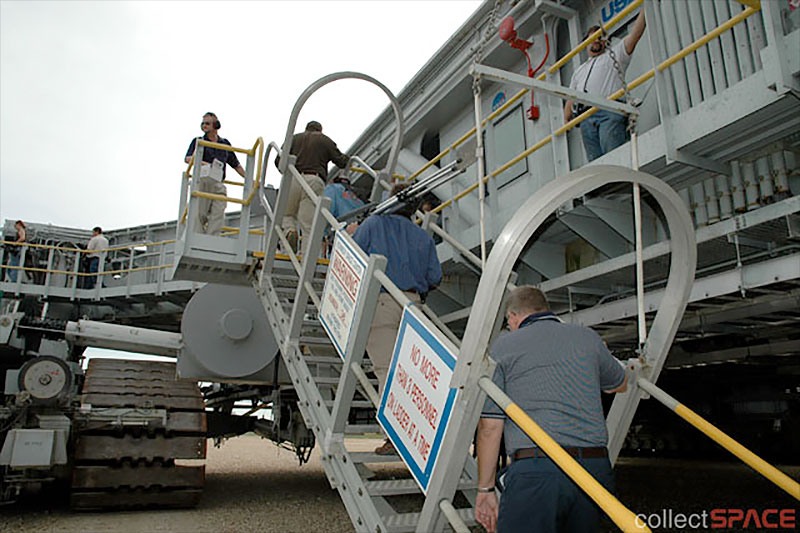
Boarding the crawler-transporter three at a time. (collectSPACE) |
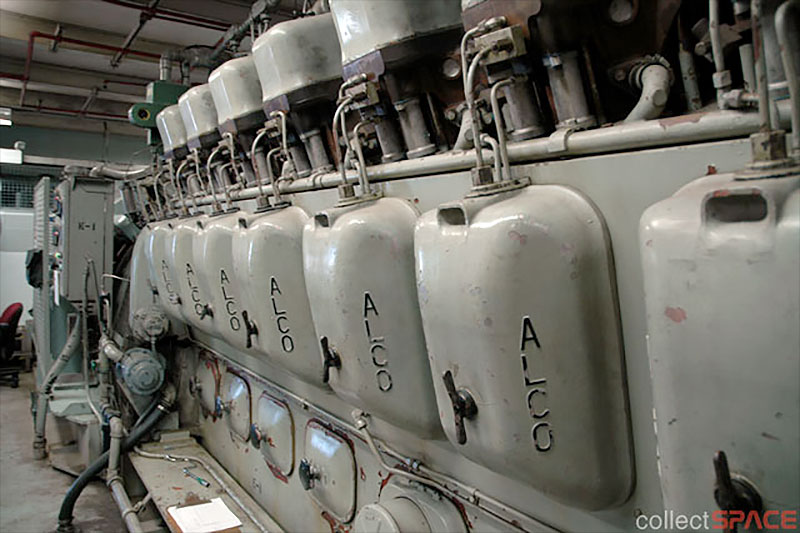
Each crawler-transporter engine has 16 cylinders. (collectSPACE) |
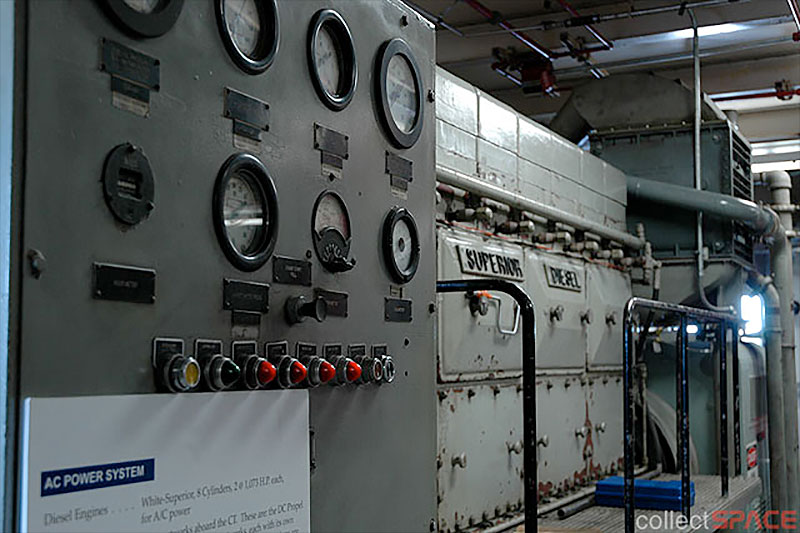
The crawler provides all power during the rollout to the pad, which includes powering the mobile launcher platform and the vehicle. (collectSPACE) |
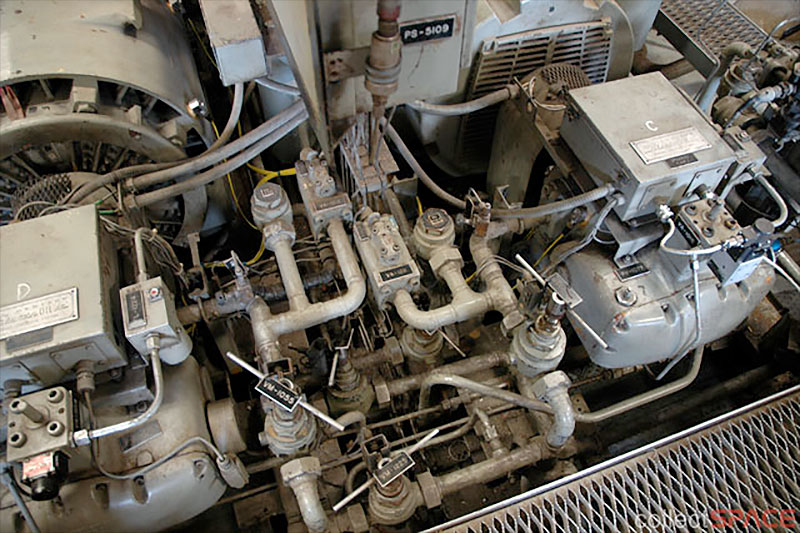
The crawler burns 125.7 gallons of diesel fuel a mile and holds 5,000 gallons of fuel. (collectSPACE) |

Touch-screen consoles inside the crawler's control room monitor the hydraulic leveling system. (collectSPACE) |
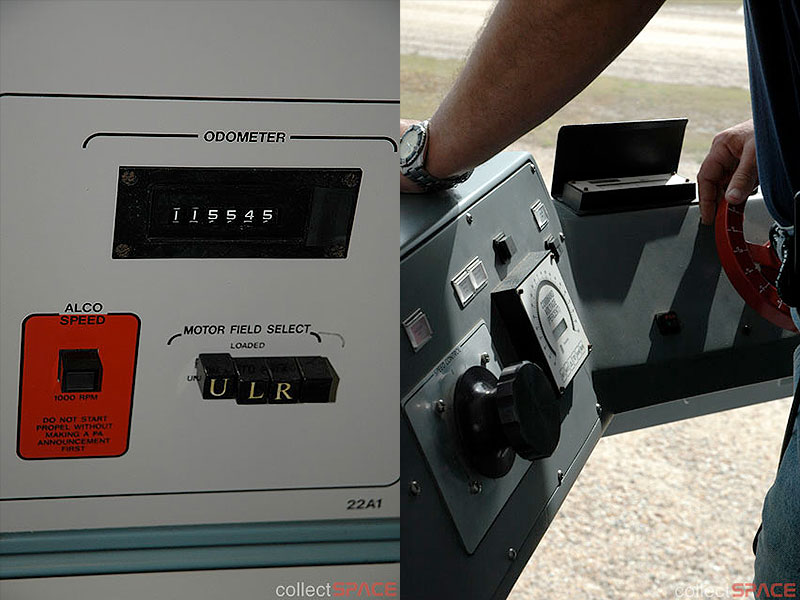
At left, each crawler has traveled 1,800 miles over their combined 40 year history. At right, knobs and wheels have taken the place of a joystick in the crawler driver's cabin. (collectSPACE) |

Peering over the top of the crawler at the Vehicle Assembly Building and Launch Control Center. (collectSPACE) |

The transporter parks before the VAB at Kennedy Space Center, awaiting its next drive. (collectSPACE) |
|

© collectSPACE. All rights reserved.
|
|

|

|
